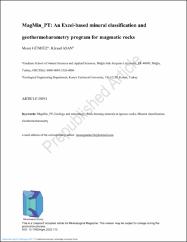MagMin_PT: An Excel-based mineral classification and geothermobarometry program for magmatic rocks
Citation
Gündüz, M., & Asan, K. (2022). MagMin_PT: An Excel-based mineral classification and geothermobarometry program for magmatic rocks. Mineralogical Magazine, 1-25. doi:10.1180/mgm.2022.113Abstract
Igneous rock forming minerals carry valuable information from the deep earth that is not directly accessible to the surface. Each phase represents physico-chemical conditions under which various magmatic processes occur at a wide range of depths from upper mantle to shallow crustal levels. These processes are cryptically inscribed in the whole-rock and mineral chemistry (e.g. major elements, trace elements, isotopic ratios) and the mineral textures (equilibrium vs. disequilibrium features), and intensive variables (e.g. pressure, P; temperature, T) as well. Therefore, special attention should be given to igneous minerals to better understand processes operated in their journey from source through magma chamber and conduit system to the earth surface. MagMin_PT is an Excel© based user-friendly program, designed to calculate mineral formulae and end-members, and to estimate pressure and temperature (e.g. geothermobarometry) from electron microprobe (EPMA) data, from magmatic rocks. The program operates the most common igneous rock-forming minerals (e.g. olivine, pyroxene, amphibole, biotite, feldspar, magnetite, ilmenite, apatite and zircon), resulting in various classification diagrams and P-T plots. Whole-rock or glass composition needs to be entered together with EPMA data into the program to check equilibration status in most P-T calculation models. Fe2+ and Fe3+ estimation is routinely performed in MagMin_PT based on the stoichiometric constrains, and machine learning method to some extent for different iron-bearing minerals. MagMin_PT is also able to carry out further calculations including fugacity, magmatic water content and saturation-temperature which are useful for igneous petrology studies. Graphical and numerical output produced by the program can be easily copied to further process in another media.


















